Rome: Curiosity
Go to : ANCIENT ROME | MEDIEVAL ROME | RENAISSANCE ROME | BAROQUE ROME | ROMANTIC ROME | MODERN ROMEANCIENT ROME

The cipher of Julius Caesar
Julius Caesar had developed an encrypted code to send his confidential messages but also used other cryptographic techniques, so much so that Valerio Probo wrote an entire treatise on the subject, which unfortunately was lost. The cipher we know today is the one that Suetonius describes in his "Life of the Caesars" ...
Continue »
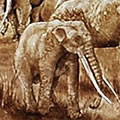
When elephants lived in Rome
200,000 years ago elephants lived along Aniene river. The valley of Aniene, the tributary that joins the river Tiber at gates of Rome, was the natural habitat of extinct animals that divided it with men who were the ancestors of the Italic aborigines ...
Continue »

The rock crystal
Rock crystal stone was consecrated to Juno because among its many powers was to channel the positive energy and bring out the capabilities of each. Rock crystal had in Roman times a very high value. Important criteria for assessing the rock crystal were naturally the transparency and the absence of inclusions; if the crystals were not always perfectly clear they were used to make objects artfully worked with decorations that dissembled impurities, it preferred not to decorate those without defects; the maximum value was by absolute transparency, the most popular must have the color of the clear water ...
Continue »

Romans used to recycle glass
The glass has an ancient history and in ancient Rome was a widespread material both in the simplest jobs than in those "artistic". In the aristocratic domus wine was drunk in glass chalices, the perfumes and theointments were stored in glass containers and windows of the houses had stained glass ...
Continue »

Lapis scandali: the stone of scandal
There was a stone in front of the major port of the Capitolium on which was depicted a lion and where they were going to sit the men who had failed and had to leave their assets to creditors ...
Continue »

The discovery of the Ara Pacis
The Ara Pacis Augustae was built between 9 and 13 B. C. to celebrate the Pax Romana achieved by Augustus after three years of victorious wars in Gaul ...
Continue »
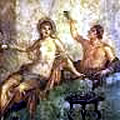
Caesar and Cleopatra drank sparkling wine
The ancient Romans loved the bollulae, it was not the nectar of the gods but it was pleasant, and maybe even better. When Caesar and Cleopatra ...
Continue »

UFO in Ancient Rome
In the sky of Ancient Rome they were sighted UFOs since archaic times. Two thousand years ago the historian Livy in his Ab Urbe condita, says ...
Continue »
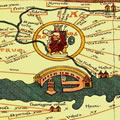
The Roman roads
The road-net of Rome in the I century was long about 100. 000 km. divided into 29 roads that were leaving from Rome and after having crossed the Italy ...
Continue »

The Nero’s doubles
On 9 June 68 AD, Nero Lucius Domitius Ahenobarbus died. He was the last emperor of the Julio-claudian dynasty. In 67, taken by repressive madness ...
Continue »

The mosaics of the Gladiators
The Borghese Gallery houses a splendid collection of mosaics floorings that depict the ludo gladiators. Cardinal Scipione Borghese was a patron, unprejudiced ...
Continue »
MEDIEVAL ROME

The prophecy of Colosseum
In the eighth century, in a Benedictine monastery in Sunderland, the monk Beda the Venerable then Doctor of the Catholic Church, in addition to writing ecclesiastical books and scientific treatises, rearranging texts of classical Latin authors, collected and reported the stories and prophecies of his time in the book "Collectanea" which reports the following obscure prophecy ...
Continue »

Finnicella, began witch hunting
Gregorovius said that June 28, 1424 on the Capitol Square was burned alive the sorceress Finnicella; it started so right from Rome the witch hunt that would bloodied all over Europe also end up in the New World ...
Continue »
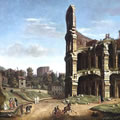
Coliseum, the Gates of Hell
In the Middle Ages the Coliseum was considered one of the seven gates of Hell and it was believed that the souls of the gladiators killed in the arena ...
Continue »
RENAISSANCE ROME

The first fireplace in Rome at the hotel of the Moon
In 1368 Francis I from Carrara, a lord of Padua, came to Rome to offer his apologies to Charles VIII, that wanted to cut his head because he didn't want to recognize him emperor and so he asked Pope Urban V for help ...
Continue »

The Gregorian calendar
The year 708 ab Urbe condita was established by Julio César ultimus annus confusionis and had the duration of 445 days to be able to re-align the duration of the calendar year with the solar year; 45 BC was the first year in which the passage of days and seasons was characterized according to the Julian calendar ...
Continue »

Grass Santacroce, tobacco of the Popes
It was the Cardinal Prospero Santacroce to do know in Rome tobacco as was then called Grass Santacroce. The Cardinal had been as papal diplomat in Germany and later ambassador in Portugal, Spain and France and it was in Portugal that he got to know a particular herb that came from the West Indies and that the natives were smoking after having rolled up the leaves or after being chopped in a pipe ...
Continue »

Market on Navona Square
In 1500 Piazza Navona was not surrounded by houses but by the gardens of the houses facing the streets that it delimited. The perimeter was marked by the ruins of ...
Continue »

Surgeons of the Pantheon
Until the XVIII century the butchers had at "Piazza della Rotonda" and the neighboring streets their workshops where prepared ...
Continue »

Annone, the elephant Pope's
In the gardens of the Vatican a whitish elephant is buried from the XVI century. It was a gift of the king of Portugal to Pope Leone X (Giovanni de Medici) ...
Continue »
BAROQUE ROME

Lottery of the Pope
The seven hundred saw Rome as a festive city, there has been a reawakening for the theatrical performances and so open up the small and large ...
Continue »

The small fountain of lovers
Near the most famous fountain in the world, Trevi Fountain, there is a small fountain that the architect Nicola Salvi created next to the monumental ...
Continue »
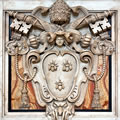
The Pope chair
On the bases of the baldachin made by Bernini in the basilica of St.Peter, there is represented the face of a woman who is giving birth. When the great work ...
Continue »
ROMANTIC ROME
MODERN ROME

The waitresses of Colonna's Cafè
When Rome became the Capital of the Italy Kingdom, the city not only changed his face with new monuments, new streets and new buildings but also changed roman society and its habits ...
Continue »
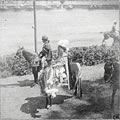
The stamp's mistery
In 1893, on the occasion of the Silver Wedding Anniversary of King Umberto I and Queen Margherita, a commemorative stamp was issued; it would have been the first commemorative stamp of the Kingdom of Italy but after having been printed its issue was canceled ...
Continue »






